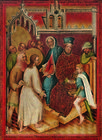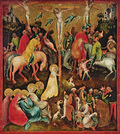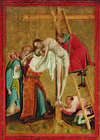Warendorf Altar
The Warendorfer Altar or Warendorfer Passion Altar is a winged altar in the St. Laurentius Church in Warendorf . It is one of the most important works of high Gothic in Westphalia. As a result of the iconoclasts of the Reformation , the secularization of the 18th and 19th centuries and the passion for art collecting in the 19th century, it now consists, similar to the Marienfelder or the Liesborn Altar , only of fragments.
history
The Warendorfer Altar is chronologically related to the high altars of the 15th century from the Westphalian School, such as in Amelsbüren , Billerbeck , Freckenhorst , Herzebrock , Langenhorst , Liesborn , Lippborg , Lünen , Marienfeld , Sassenberg , Schöppingen , Soest , Vinnenberg , and Werne .
A major fire on September 22nd, 1404 destroyed the church, town hall, school, mill and around 600 town houses in Warendorf. On this occasion, the church was rebuilt just ten years later. In 1414 an altar was inaugurated in Warendorf. Whether it was already designed as a winged altar at that time remains unknown. The time of origin is assumed between 1420 and 1430. It is believed that it was made in the workshop of the master from Münster and that it decorated the high altar of the St. Laurentius Church in Warendorf between 1430 and 1690 with 16 pictures on two side wings. In 1607 the altar was freshened up by Pastor Hover at his expense. Then it had to give way to the changing taste of the time and was replaced by a baroque altar and initially housed elsewhere in the church and was finally hung in the sacristy until 1814. Then the church and the sacristy were cleaned and stripped of all pictures and statues, which, according to the view of the time, represented an evil.
Double doors
The two double doors were sold and little is known about their whereabouts. The panels painted on both sides were probably also sawn in the middle. Three fragments (the flagellation, the Whitsun feast and the capture of Jesus), whose affiliation to the Warendorf Altar was uncertain for a long time, are in Freckenhorst. According to tradition, parish dean Schulte acquired these paintings in Warendorf at the beginning of the 19th century. The Martyrdom of Saint Laurentius was bought by the private collector Alexander Haindorf in Münster. From this collection it came to Berlin via Hamm, and finally to the collection of the LWL Museum for Art and Culture in Münster. Two further panels, the Annunciation and the Mount of Olives Scene, once the front and back of the same panel, came to the State Museum from the old Westphalian collection of von und zu Mühlenschen in Münster. The double image “Condemnation of St. Laurence” and “Last Judgment” served as the door opener of the sacrament house in Warendorf for over 50 years and was made available to the State Museum on permanent loan. A total of seven of the 16 sculptures have been lost.
Middle part
The middle part remained in Warendorf, was sold by the provisional or Rendant Hase from the old parish to the widow Schade for 4 Rtlr. Unaware of its real value, she had hung it in her kitchen, where it was exposed to smoke from the fire and other pollution. Finally she sold it to the vice-principal Ludwig Tross from Hamm for 50 Rtlr. He had the picture refreshed in Münster in order to sell it for a profit to the Royal Museum in Berlin. At the intervention of the district administrator in Münster, which was turned on by the mayor of Warendorf, Tross was ready to return the picture to the church for 400 Rtlr. However, this was rejected by the state government because the sale was illegal. Eventually it was agreed that the Church Tross would reimburse its costs. Tross claimed the purchase price of 50 Rtlr, the freight to Munster and the cost of refreshment with 22 Rtlr 7 1/2 Sgr and returned the picture. In the middle of the 19th century, the painting in need of repair was handed over to Mr. Böcker for assessment. Later it was shown in an exhibition of the Westphalian Art Association . Attempts to send the picture back to the parish in Warendorf initially went unanswered. From 1859 to 1888 one had to intervene several times until the picture was finally sent back.
renovation
Josef Goeken made the first thoughts on the reconstruction of the altar. His essay in the "Warendorfer Blätter für Heimatpflege und Kultur" probably promoted the renovation of the picture as well as the church, if not initiated, then at least significantly. Between 1968 and 1974 the middle section and the three Freckenhorster pictures were extensively restored by the state museum's restorer, Ms. Eleonore Roskamp-Klein. Following a church renovation, the arrangement of the altar from the fragments was determined by Max von Hausen in 1978. At the suggestion of Géza Jászai, large brown and white photos were taken of these panels and placed in the side wings, a temporary solution that found a different solution after twenty years. In March 1998 the photos - computer technology makes it possible through digital image processing - were replaced by colored prints that are protected with a UV film. For this purpose, new ektachromes were made from all the boards in Münster and Freckenhorst by Mr. Wakonigg, the photographer of the Landesmuseum Münster. Nevertheless, half of the side wing images must be considered lost.
description
The Warendorf Passion Altar has a height of 1.95 m with the two wings and a width of 5.90 m, so it is exactly three times as wide as it is high. The central picture has the dimensions 1.70 × 2.65 m. The wings were painted on both sides and were 79 × 54.5 cm in size. Both the central panel and the wings are surrounded by a frame of approx. 10 cm. The pictures are painted on oak wood with a chalk base, which is often backed with linen. There must have been a predella , but nothing is known about it.
Main picture
Details of the Calvary scene
The dimensions of the main picture represent the image of the calvary, which has remained in Warendorf as before. It shows what happened on Good Friday, immediately after the death of Jesus. In the center the body of Christ hangs on the trunk of the cross with three nails attached. From his wounds flows the blood, which is caught by angels with golden goblets; a clear indication of the sacramental character of the sacrificial death of Jesus. To his right is the cross of the good thief; an angel is ready to take his soul to heaven. On the left is the cross of the bad thief, with the devil already on his neck. In the background the typical gold of the Gothic. The events around the group of crosses are divided into two levels. On the left side of the picture, the blind Longinus , sitting on horseback, holds a lance in both of his hands. This is led into the side of Jesus by a servant. According to legend, the blind person regains his sight through the blood of the side wound so that he can recognize the divinity of Christ. On the right side of the picture is the good captain, also on horseback. With the words: "Truly, this man was the Son of God" (Mk 15,39b) he testifies to the divinity of Jesus. On the second level, on the left edge of the picture, the mourners and mourners are depicted: Maria Magdalena hugs the trunk of the cross; Mary, the mother of Jesus in the midst of other women who support her, John looks up to the cross. The consequences of the earthquake can be seen around the cross: the graves open and the dead awaken. On the lower right side Pontius Pilate is shown with the scribes. Pilate had a sign made with the inscription: "Jesus of Nazareth, the King of the Jews." The high priest protests: “Do not write: The King of the Jews, but that he said: I am the King of the Jews.” Pilate replies: “What I have written, I have written.” (Jn 19: 19-22) This is also written on the governor's scroll: "Quod scripsi scripsi." On the titulus of the cross there is the usual initial abbreviation: INRI (Iesus Nazarenus Rex Iudaeorum). The effect that the image has on the viewer can best be demonstrated by a quote from Josef Goeken:
“The mighty picture wall must have had a splendid effect in the choir, which in the past certainly had the color scheme peculiar to the Gothic period. Pale delicate and glowing colors alternated in a lively rhythm, mysteriously glowing and shimmering in front of the golden background. Of all the glory, the Old Church happily remained the centerpiece. It has strong, warm colors and a peculiar magic. The leaning and swaying of the slender horse's necks and livers, the painful leaning against one another of the women under the cross, the way Magdalena clasps the trunk of the cross and Mary leans over her dead son, is extremely delicate and delicate in feeling. The picture breathes a solemn atmosphere and is of such simple size and depth of feeling that it is rightly emphasized as particularly characteristic of Old Westphalian painting and ascribed to a master who, apart from Conrad von Soest, is the only one who asserts high rank in time and place. "
Sequence of images
The sequence of images of the original remains controversial, as half of the images on the two double doors have been lost; One can only speculate about their subject matter. Thus, the actual direction of the statement remains hidden. What is certain is that it is about the Passion of Christ and the legend of St. Laurentius goes. In 1930 Joseph Goeken made the following interesting suggestion: According to this, the story of Mary on the left closed wing and the story of St. Laurentius on the right closed wing came to be illustrated.
Reconstruction proposal based on Joseph Goeken 1930
| closed left wing | left wing | Middle part | right wing | closed right wing |
|---|---|---|---|---|
|
|
|
|
|
On this basis, Paul Pieper made a reconstruction proposal with further additions.
Addition to the reconstruction proposal according to Paul Pieper
| closed left wing | left wing | Middle part | right wing | closed right wing |
|---|---|---|---|---|
|
|
|
|
|
This preparatory work is followed by today's sequence of images: left wing: Annunciation, Christ on the Mount of Olives, Christ's arrest, Christ's flagellation. The center piece shows the scene on the Calvary in the center and on the sides: Christ before Pilate, carrying the cross, descent from the cross, entombment. The right wing shows Pentecost, Last Judgment, condemnation of St. Lawrence and the torture of the saint.
Today's sequence of images
| closed left wing | left wing | Middle part | right wing | closed right wing |
|---|---|---|---|---|
(Detail from the Annunciation) |
|
|
|
(Detail from the conviction) |
Whereabouts
The fragments of the Warendorf Passion Altar can be viewed at three locations:
- 1. St. Laurentius Church in Warendorf
- 2. St. Bonifatius in Freckenhorst
- 3. LWL Museum for Art and Culture in Münster
photos
Nevertheless, the known fragments were replaced by copies in Warendorf. This cannot compensate for the loss of the seven pictures, but the viewer gets a good overview of the main message of the Warendorf Passion Altar: the salvation history of Christ, from the Incarnation to his return in the Last Judgment.
“A long odyssey has now come to a temporary end. May the images of the Warendorf Passion Altar, the message of God's love and loyalty to people, as expressed by the master of the Warendorf Altar in the imagery of his time, also find open hearts in our hearts today. "
Web links
- www.stlaurentius-warendorf.de (PDF; 200 kB)
Individual evidence
- ^ Karl Hölker: Bau- und Kunstdenkmäler von Westfalen, edited by Wilhelm Rave Provinzialkonservator 426 on behalf of the Provincial Association. Volume: District Warendorf, Aschendorffsche Verlagsbuchhandlung, Münster 1936 p. 426.
- ^ Karl Hölker: Bau- und Kunstdenkmäler von Westfalen, edited by Wilhelm Rave Provinzialkonservator 428 on behalf of the Provincial Association. Volume: District Warendorf, Aschendorffsche Verlagsbuchhandlung, Münster 1936 p. 428.
- ↑ The Warendorfer Altar in The Warendorfer Altar in St. Laurentius A masterpiece from the High Gothic in Westphalia, p. 14
- ^ Walter Suwelack: The adventurous ways of the Warendorfer Passion Altar from 1430 to 1998 in The Warendorfer Altar in St. Laurentius A Masterpiece from the High Gothic in Westphalia, p. 6
literature
- Karl Hölker: architectural and art monuments of Westphalia . On behalf of the Provincial Association, edited by Wilhelm Rave Provincial Conservator 42nd Volume: District Warendorf, Aschendorfsche Verlagsbuchhandlung, Münster 1936
- Franz Kroos: The Warendorf Passion Altar in Sankt Laurentius, a masterpiece from the high Gothic in Westphalia , Warendorf 1979
- Géza Jászai: The Warendorfer Altar , Warendorf 1998


















